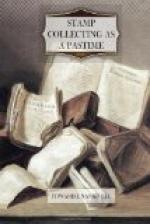[Illustration:]
[Illustration:]
VIII.
Great Rarities.
Of the many stamps that are set apart, for one cause or another, from the ordinary run, as having a history of their own, those that by the common consent of collector and dealer are ranked as great rarities are the most fruitful source of astonishment to the non-collector. They are the gems of the most costly collections, the possession of the few, and the envy of the multitude. In a round dozen that will fetch over L100 apiece there are not more than one or two that can lay any claim to be considered works of art; indeed, they are mostly distinguished by their surpassing ugliness. Nevertheless, they are the gems that give tone and rank to the finest collections. Some of them are even priceless.
To the average man it is astonishing that anyone in his senses can be so foolish as to give L1,000 for an ugly little picture that has merely done duty as a postage stamp. He contends there can be no intrinsic value in such scraps of paper, and that settles the matter, in his opinion. But is it not so with precious stones and pearls? They are of value merely because they are the fashion. There is no intrinsic value in them. If they were not fashionable they would be of little or no value. Long-standing fashion, and fashion alone, has given them their value. So it is with stamps; fashion has given them their value, and every decade of continued popularity adds to that value as it has added to the value of precious stones and pearls. There is no sign that precious stones are likely to become worthless by the withdrawal of popular favour. Fashion changes from one stone to another without affecting the popularity of precious stones in general. So it is with stamps. Fashions change from one line of collecting to another without in the slightest degree affecting the stability or popularity of collecting as a whole. Precious stones and pearls minister to the pride of the individual, and stamps to his pleasure; and each has its own strong and unshakable hold upon the devotees of fashion and pleasure. There is a fluctuating market in the case of each of these favourites, but I venture to think that there is, and has been for the past forty years, a steadier rise in the value of stamps than in the value of precious stones.
[Illustration:]
British Guiana, 1856, 1 c.—In 1856 this colony was awaiting a supply of stamps from England, and pending its arrival two provisional stamps were issued, a 1 c. and a 4 c. These were set up from type in the office of the Official Gazette. A small illustration of a ship, used for heading the shipping advertisements in the daily papers, was utilised for the central portion of the design. Of the 1 c. value only one specimen is known to-day, and that is in the collection of M. Philipp la Renotiere (Herr von Ferrary). Doubts have been expressed as to the genuineness of the copy, but Mr. Bacon, who has had an opportunity of inspecting it, says: “After a most careful inspection I have no hesitation whatever in pronouncing it a thoroughly genuine one cent specimen. The copy is a poor one, dark magenta in colour, and somewhat rubbed. It is initialled ‘E. D. W.’, and dated April 1st, the year not being distinct enough to be read.”




